TenderMint: Consensus without Mining
Jae Kwon
yk239@cornell.edu
Draft v. 0.3
Abstract. Cryptocurrencies such as Bitcoin enable users to submit
payment transactions without going through a centralized trusted orga-
nization. The blockchain provides part of the solution, but much of the
benefits are lost in securing the blockchain with computational proof-
of-work mining which is needlessly expensive and slow. We propose a
solution to the blockchain consensus problem that does not require min-
ing by adapting an existing solution to the Byzantine Generals Problem.
1. Introduction
Cryptocurrencies have come into the spotlight since the introduction of Bit-
coin [1]. The Bitcoin transaction log is secured by a network of miners who compete
for rewards in the blockchain. This mining, or proof-of-work, comes with a hefty
cost. At today’s Bitcoin prices and reward schedule, miners are rewarded on the
order of $1,500,000 a day to secure the blockchain – and a significant portion of that
money is spent on electricity. Proof-of-work based consensus algorithms are also
slow, requiring up to an hour to fully confirm a payment to prevent double-spending.
Other protocols (e.g. proof-of-stake protocols) have been proposed by the
cryptocurrency community to solve this problem, but they typically suffer from
the fallacy of false choices; nodes have nothing to lose by contributing to multiple
blockchains, so consensus is not guaranteed. Unless there is actually “something at
stake”, all participants would be incentivized to sign any block that they encounter
to earn fees. Yet other protocols suffer from assumptions of good behavior on the
part of some participants, but these assumptions don’t hold when the participants
are financially motivated.
Our protocol overcomes the fallacy of false choices problem by requiring a
surety bond deposit to participate in the consensus mechanism, ensuring consensus
at every block, and strongly incentivizing participants to only sign the block agreed
upon. We make a weak assumption about the participant’s abilities to keep time,
and we assume partial synchrony of the network. Our algorithm is based on a
modified version of the solution to the Byzantine Generals Problem by Dwork,
Lynch, and Stockmeyer [2], and is resilient up to 1/3 of bonded coins belonging to
byzantine participants.
2. Terms
1
�
Nodes are connected to each other in a peer-to-peer fashion and relay new
information by gossip. Each node keeps a complete copy of a totally ordered se-
quence of events in the form of a blockchain as in Bitcoin. Users (clients) keep
an account in the system, where the user’s account is identified by the hash of the
user’s public key called an address. Each account can hold a sum of coins that can
change with new transactions. Nodes relay new transactions as they are signed and
submitted by users to a node of the network. There are 3 types of transactions.
• Send: Send some amount of coins from the signer’s account to another.
• Bond: Lock coins as a surety bond.
• Unbond: Unlock the bonded coins.
A transaction is valid if it follows the rules of our protocol (e.g. sufficient
funds to send, etc). Valid transactions are grouped into blocks. A block is valid if
all the transactions in the block are valid. Validators are users with accounts that
have bonded coins. We say that a validator has voting power in the amount of the
bonded coins. Validators are good if the validator acts according to the protocol.
Other validators are considered byzantine. Blocks are proposed and then committed
into the blockchain by validators using the consensus algorithm. The network is
responsive if transactions that pay sufficient fees get committed in a timely manner.
3. Validators
An account becomes a validator by posting some amount of coins as a surety
bond. Once the bonding transaction is committed, the validator can participate
in the consensus protocol with voting power in proportion to the amount of coins
bonded. Bonded coins cannot be used in any transaction except for an unbonding
transaction, afterwards the coins remain locked in the unbonding period of X blocks.
If the validator fails to meet its obligations before the unbonding period is over, the
validator can lose all of its bonded coins. The validator fails to meet its obligations
if any of the following occur:
• Signing two conflicting messages at the same block height
• Signing an invalid checkpoint
Given the punitive nature of the algorithm and the long unbonding period,
validators with significant voting power are unlikely to sign conflicting or invalid
messages (at least until the unbonding period is over).
4. Consensus
4.1 On Byzantine Consensus
2
�
While most existing literature on byzantine consensus systems assume that
each process is a discrete unit with equal weight and import, we extrapolate these
studies into our problem domain where abstract processes (validators) have frac-
tional presence in the form of voting power.
Fischer et al have shown in a seminal paper [3] that in an asynchronous
system (where no assumptions are made about time) of deterministic processes,
no protocol can guarantee consensus even with one faulty process. This is called
the FLP impossibility result. Much research has gone into understanding ways
to circumvent the FLP impossibility result by slightly modifying the problem do-
main, e.g. by sacrificing determinism, adding time, adding oracles etc [4]. Bitcoin
circumvents the FLP impossibility result by making some assumptions about the
synchrony of the network (i.e. nodes soon sync up with the network) and time (i.e.
miners dedicate limited time and resources to the best blockchain). For example,
if the Bitcoin network were such that the time for a block to be broadcasted takes
longer than some multiple of the average block generation time, a minority mining
pool with a superior connectivity can keep the network forked indefinitely.
Our algorithm is based on algorithm 2’ from section 4 of [2] (Dwork et
al).
It assumes that the network is partially synchronous; there is assumed to
be some unknown upper bound ∆ on the time of messages to be delivered. We
also assume that all non-byzantine nodes have access to an internal clock that can
stay sufficiently accurate for a short duration of time until consensus on the next
block is achieved. The clocks do not need to agree on a global time. It is possible
to construct a consensus protocol with weaker assumptions about the validator’s
clocks [2], but we omit this possibility for simplicity. Like the algorithm as proposed
by Dwork et al, it can tolerant of up to 1/3 byzantine voting power.
4.2 On Byzantine Consensus
The blockchain is composed of sequential blocks connected by the hash of
each block, which is computed by hashing the contents of the block.
Figure 1: Block chain
A block is composed of a header (which includes information such as the
block’s height) and three hashes:
• The previous block’s hash
• The root hash of a merkle tree of validator signatures for the previous block
3
�
• The hash of a list of new transactions
When a validator signs a block at height h, the signatures get hashed into
a merkle tree and the result gets included in the next block. The signatures are
ordered by the ordinal of the validator (i.e. by the chronological order of the
validator’s address), and missing signatures are denoted by an empty sequence of
zeros.
Figure 2: Signatures merkle tree
The transactions hash need not be a merkle tree.
Figure 3: Transactions
4.3 Agreeing on the next block
After each validator sees that a more than 2/3 of the voting power has signed
for the block(s) at height h-1, the consensus mechanism begins for the next block
at height h.
Lemma 1: The consensus mechanism for block height h for all good validators begins
within ∆ of each other in global time.
The proof follows from the definition of ∆. The first good validator to see at
least 2/3 of voting power for the previous block will broadcast all those signatures
by gossip, thus all remaining good validators will see at least 2/3 of voting power
for the previous block within ∆ .
4
�
Let T be some fixed duration of time that is suspected to be at least 2∆.
We don’t know what ∆ actually is, so T is merely a guess that is baked into the
algorithm. Let W ≥ T be some lower threshold on the amount of time between
each successive block. The consensus mechanism begins by first waiting W , then
proceeds in rounds until consensus is reached.
wait W & gossip votes for the previous block
loop starting with i=0:
run consensus round i
At each consensus round, a single validator is chosen to propose a block.
Any deterministic algorithm based on the existing blockchain history can be used
to compute a total ordering of validators, but we want one that gives more priority
to those with more voting power such that validators with less voting power have
less chances to disrupt the responsiveness of the system. Before the consensus
mechanism starts for the next block, a number and order is computed for each
validator:
// calculate sorted list of validators:
sortedValidators = nil
for each block:
for each validator:
validator.accum_power += validator.power
if sortedValidators != nil:
sortedValidators[0].accumPower -= validator.power
sortedValidators = sort(validators, fn(v){ v.accumPower })
From hereon, a proposer is chosen for each round according to:
// function definition
fn getNextProposer():
proposer = sortedValidators[0]
for each validator:
validator.accumPower += validator.power
proposer.accumPower -= validator.power
sortedValidators = sort(validators, fn(v) v.accumPower )
return proposer
Each consensus round is composed of two steps. Each of these two steps
takes T + iδ where δ is some fixed increment of time, so each round is longer than
the last one by 2δ. Any messages to be broadcasted are sent in the beginning of the
step, and messages can be received in the background during the entire duration of
the step.
// consensus round i for height h for validator V:
// (
)σ is a message signed by validator V.
// A is composed of a block, a blockhash for that block,
// and a list of s from the previous round.
lastVote = nil
5
�// step 1: Propose
proposer = getNextProposer()
if proposer == self:
if i == 0:
broadcast (
, blockhash, nil>)σ
else:
broadcast (, blockhash, [,...]>)σ
wait for T+i*δ
else:
receive for T+i*δ
// step 2: Vote
if no proposal was received or proposal is unacceptable:
broadcast ()σ
else if the proposal is acceptable:
broadcast ()σ
if isDeciding(proposal, blockhash):
decide()
receive others’ s for T+i*δ
A proposal is acceptable if the block is valid and either the round is 0 or the
proof of acceptability (list of messages from the previous round included in
the proposal) consists of at least 2/3 of the voting power, where the vote value is
either nil or equal to the block hash of the proposed block. Intuitively, a vote for
nil is like a vote for any block. If at least 2/3 of the voting power in the proof of
acceptability is explicitly for the proposed block (rather than nil), the proposal is
deciding and the recipient decides on that proposed block by signing the block.
Lemma 2: If there are less than 1/3 in byzantine voting power & if at least one good
validator decides on a block, then all good validators will decide on the same block
eventually.
A good validator will only decide on a block if the block is explicitly voted
for by at least 2/3 the voting power in the previous round. Since there are less than
1/3 in byzantine voting power, more than 1/3 of the voting power will remain true to
the algorithm and continue to vote for the same block going forward, and will not
change their vote to a different block unless it encounters an acceptable proposal
for a different block. However, no proposal for a different block can be acceptable.
Lemma 3: If there are less than 1/3 in byzantine voting power, consensus is eventu-
ally reached (the algorithm terminates).
The proof is similar to the one in [2].
4.4 Committing to the agreement
While the consensus mechanism in the previous section gets good validators
6
�to agree on the next block, we also need to ensure that validators stick to their
commitments for blocks previously decided upon. We achieve this by incentivizing
validators to sign the agreed upon block by rewarding them with transaction fees in
proportion to their voting power, and strongly incentivizing validators to sign only
one block at a given height. When signing a block, a validator must sign a string
that includes the block’s hash as well as the block height. When a block cheats
by signing more than one block on the same height, a short evidence transaction
can be included by anyone as long as it is committed before the cheater’s bonded
coins are released (after the unbonding period). When such evidence is found
and committed, that validator’s bonded coins get redistributed to the remaining
validators in proportion to their voting power immediately.
Figure 4: Evidence of duplicated height
As long as there are less than 1/3 in byzantine voting power, each successive
block in the blockchain will have at least 2/3 in votes. Thus given a parent block,
the correct child block is the one that has at least 2/3 in votes, and this uniquely
identifies the current blockchain fork.
4.5 Cooperation
Since validators divide the transaction fees of block h amongst themselves, a
greedy validator might be tempted to exclude some signatures when proposing the
next block h+1. This is an inferior strategy when considering that other validators
are game optimal participants. Given that the total amount of fees to be divided
in a block is f1, and that the sum of the voting powers vi of all validators that
have signed and successfully propagated their signatures is 1, consider proposer P
with voting power vp < 1 who is considering whether to include validator Alice’s
signature with voting power va < 1. At stake is Alice’s fair share of the fees which
is f1 · va. Of this, P ’s incremental benefit of excluding Alice’s signature is:
f1 · va · vp/(1 − va)
Then, Alice could react tit-for-tat by excluding P ’s signature when it be-
comes Alice’s turn to propose the next block, where the sum of the fees in that
block is f2. In that case, P ’s detriment is:
f2 · vp
7
�
P only gains a monetary advantage if the benefit outweighs the costs where:
f1 · va · vp/(1 − va) > f2 · vp
f1 > f2/(va/(1 − va))
Thus if P and Alice’s interactions were limited such that they only get to
propose one block each, it’s clear that P doesn’t benefit overall unless the proposed
block contains a much larger sum of fees f1 in reward than what Alice’s later block
will contain, f2, assuming va 1. Even if Alice’s voting power is large, she could
divide her stake amongst multiple smaller accounts. In the case where P and Alice
aren’t limited to propose one block each, P and Alice might exclude each other’s
signatures indefinitely. In this case, P ’s expected benefit on each block is:
E[f ees] · va · vp · vp
whereas P’s expected detriment on each block is:
E[f ees] · vp · va
No matter the amount of voting power, no two validators benefit by ex-
cluding each other’s signatures indefinitely. Intuitively, this is because the other
validators gain more when two validators exclude each other.
5. Checkpoints
While the protocol described so far is theoretically feasible, in practice there
are computational, storage, and network limitations to consider. We want to allow
for as many validator nodes as possible, but it may be too costly to store every
validator’s signature for every block. For a concrete example, we estimate the total
number of unique active miners in Bitcoin to be on the order of 50,000. If every
validator signed every block and consensus was reached on average every minute,
and each signature were 32 bytes long, that totals to 840 Gb of storage every year
just for validator signatures. For this reason we propose a checkpointing system
such that the validator signatures of most blocks can be pruned away.
Every 240 blocks a checkpoint is created that summarizes the voting activity
of each validator. The checkpoint data structure is hashed into a merkle tree and the
root hash is included in the next block. Each row in the checkpoint data structure
corresponds to a validator, ordered by the age of the validator. In the figure below,
validator #4 has been offline and not signing anything.
8
�
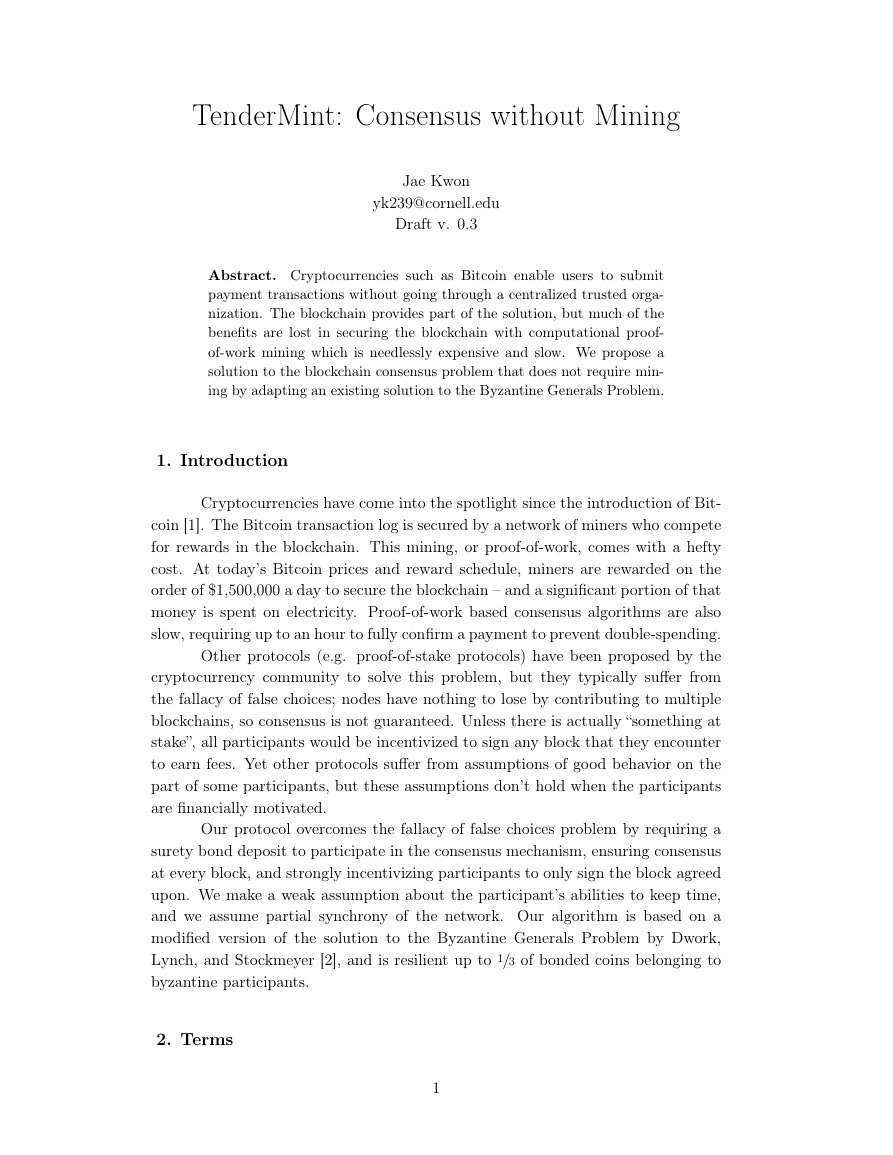

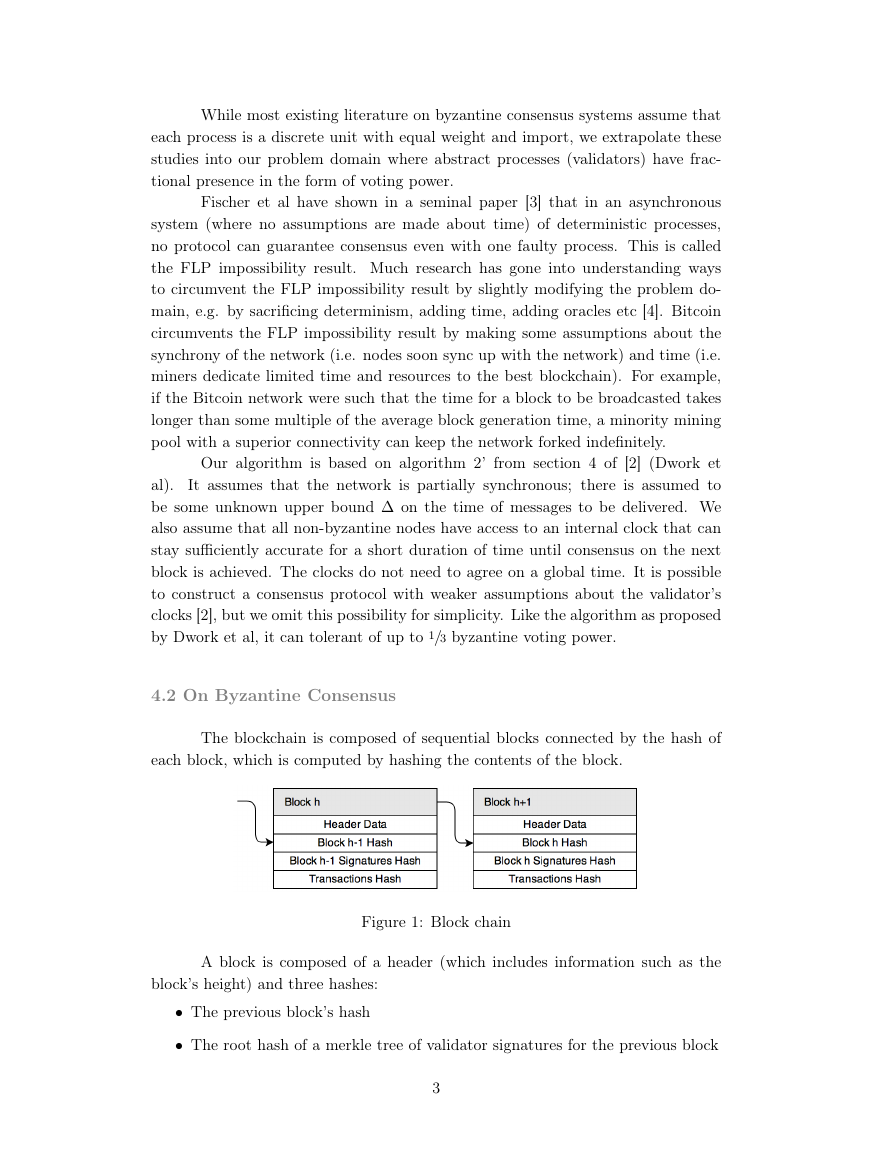

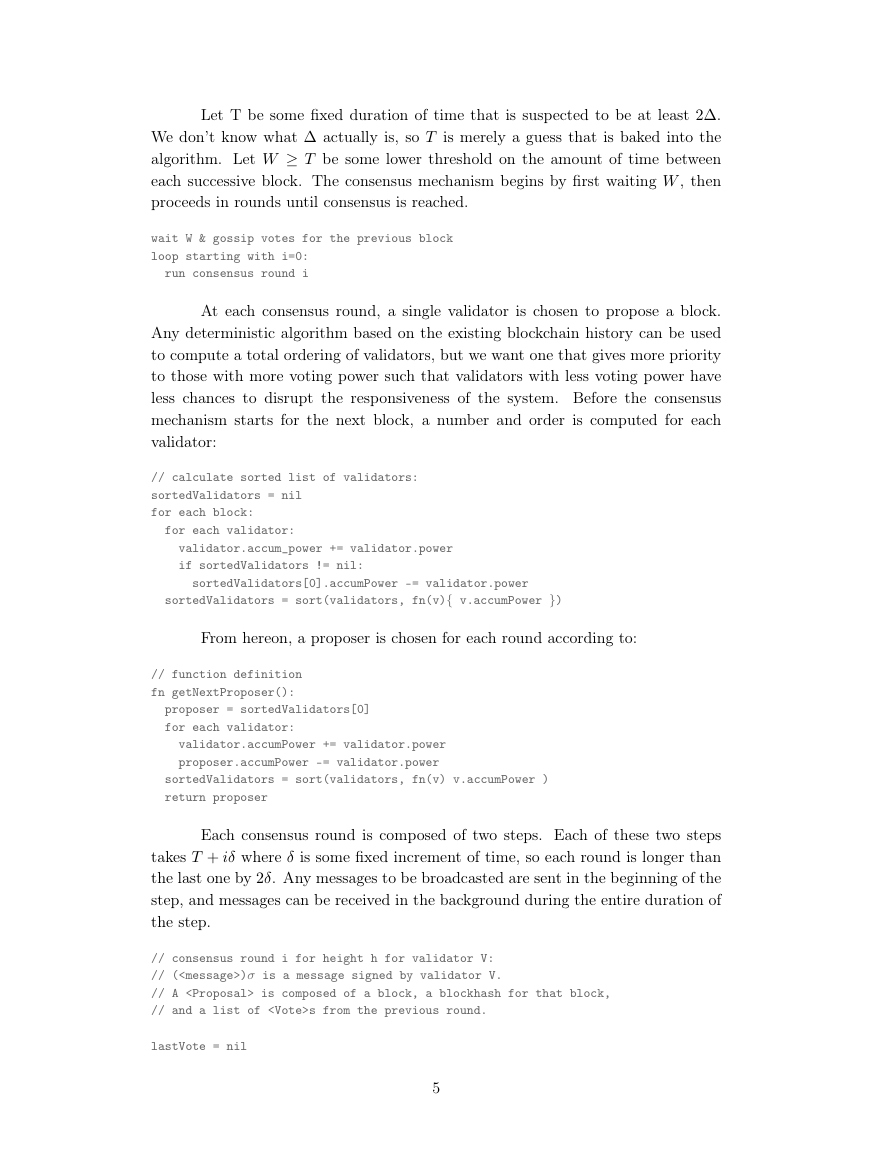
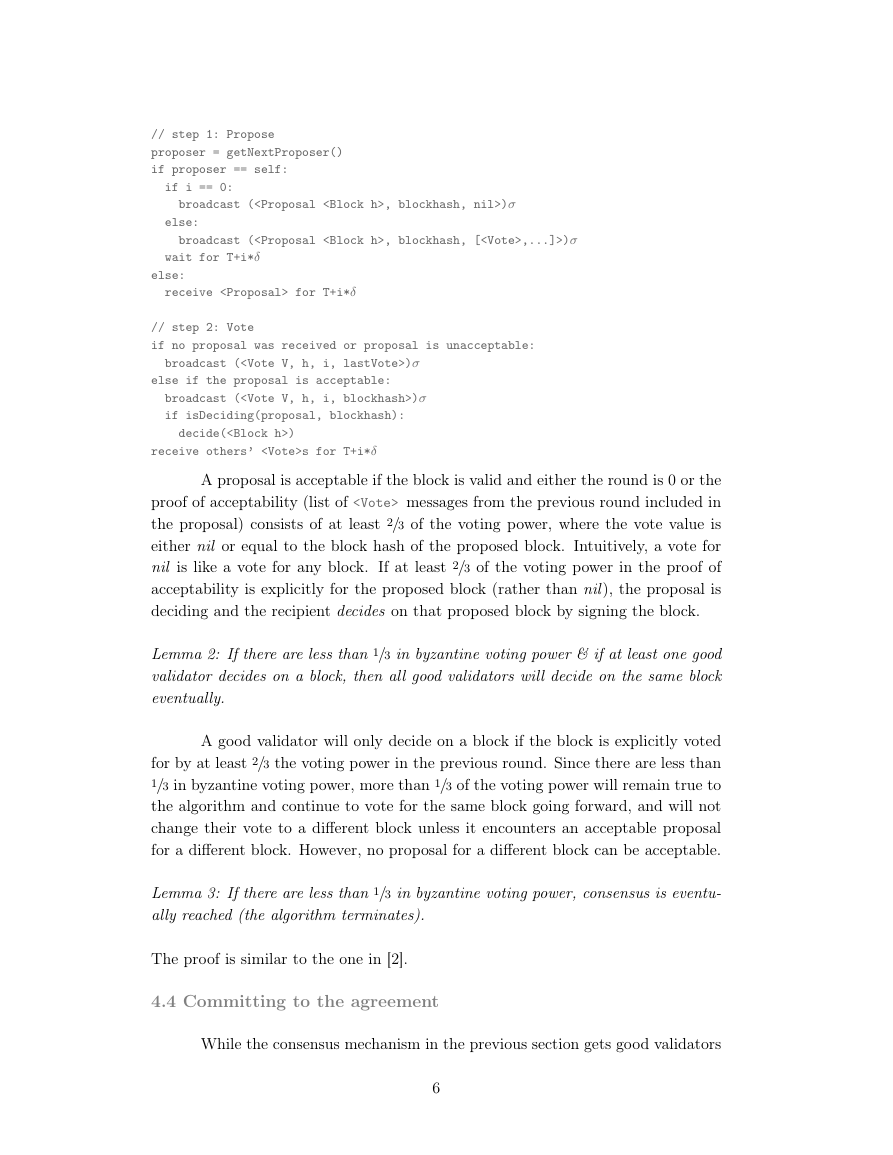
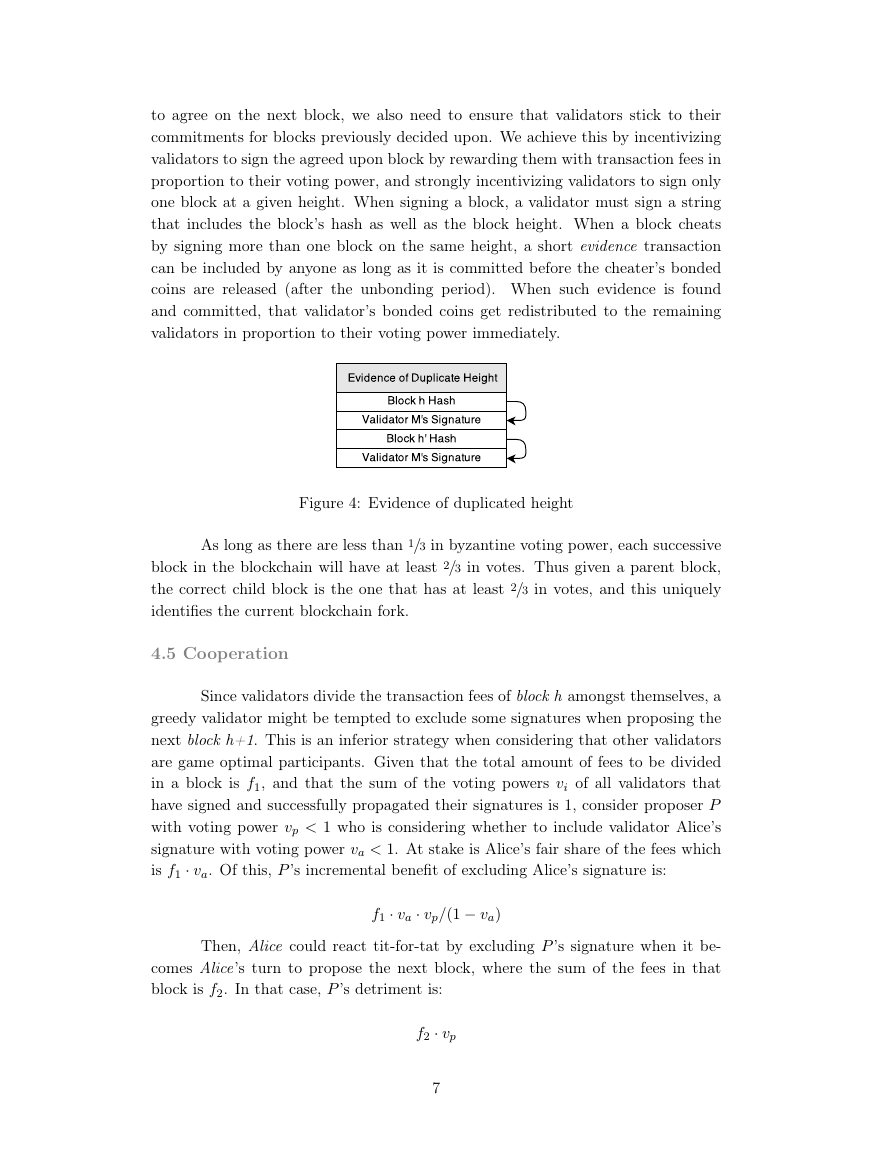









 2023年江西萍乡中考道德与法治真题及答案.doc
2023年江西萍乡中考道德与法治真题及答案.doc 2012年重庆南川中考生物真题及答案.doc
2012年重庆南川中考生物真题及答案.doc 2013年江西师范大学地理学综合及文艺理论基础考研真题.doc
2013年江西师范大学地理学综合及文艺理论基础考研真题.doc 2020年四川甘孜小升初语文真题及答案I卷.doc
2020年四川甘孜小升初语文真题及答案I卷.doc 2020年注册岩土工程师专业基础考试真题及答案.doc
2020年注册岩土工程师专业基础考试真题及答案.doc 2023-2024学年福建省厦门市九年级上学期数学月考试题及答案.doc
2023-2024学年福建省厦门市九年级上学期数学月考试题及答案.doc 2021-2022学年辽宁省沈阳市大东区九年级上学期语文期末试题及答案.doc
2021-2022学年辽宁省沈阳市大东区九年级上学期语文期末试题及答案.doc 2022-2023学年北京东城区初三第一学期物理期末试卷及答案.doc
2022-2023学年北京东城区初三第一学期物理期末试卷及答案.doc 2018上半年江西教师资格初中地理学科知识与教学能力真题及答案.doc
2018上半年江西教师资格初中地理学科知识与教学能力真题及答案.doc 2012年河北国家公务员申论考试真题及答案-省级.doc
2012年河北国家公务员申论考试真题及答案-省级.doc 2020-2021学年江苏省扬州市江都区邵樊片九年级上学期数学第一次质量检测试题及答案.doc
2020-2021学年江苏省扬州市江都区邵樊片九年级上学期数学第一次质量检测试题及答案.doc 2022下半年黑龙江教师资格证中学综合素质真题及答案.doc
2022下半年黑龙江教师资格证中学综合素质真题及答案.doc